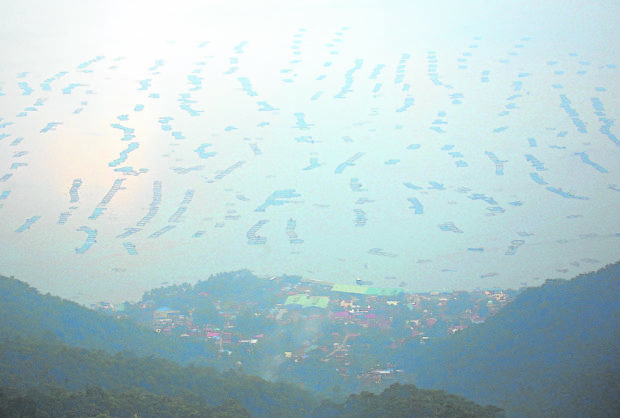
IN A VOG Taal Lake becomes a hazy memory of fish pens as sulfur dioxide emissions from Taal Volcano blanket the volcano island and the towns overlooking it. According to the Philippine Institute of Volcanology and Seismology (Phivolcs), the country’s second most active volcano spewed 14,326 tons of gas emissions on Monday, forcing residents of Talisay town in Batangas to stay indoors. —LYNRILLON
MANILA, Philippines — Taal Volcano’s emission of “dark phreatomagmatic plume” on Thursday may cause ashfall but only over areas closest to it and not expected to reach as far as Metro Manila.
The Philippine Institute of Volcanology and Seismology (Phivolcs) said that in the event ashfall ensue, it would only be on towns southwest of the restive volcano such as areas near the Balayan Bay like San Luis, Taal, Agoncillo, Lemery, and Calaca.
“Masyadong mababa ‘yong pagputok kanina, kung meron mang ash fall ‘yon ay baka bahagya lang at mainly sa crater, at baka doon mapupuntang kaunti sa southwest. Dapat by this time, kung meron mang umabot sa mainland ay naramdaman na ‘yon,” Phivolcs director and Undersecretary Renato Solidum said in a press briefing.
“Pero mainly ‘yong larawan kanina, makikita mo na ang concentration ng mga maiitim na particles ay doon lamang sa crater,” he added.
Earlier Thursday, Taal Volcano belched a kilometer-high dark phreatomagmatic plume leading people to fear that scenarios of its January 2020 explosion would happen all over again. More than a year ago, Taal erupted and caused ashfall that affected areas as far as Metro Manila as well as towns in Central Luzon.
READ: Taal Volcano erupts
READ: Taal volcano spews ash in phreatic eruption
But Solidum still noted it is important to wear masks to protect people from inhaling volcanic dust if in case ashfall incidents occur. He, however, also reminded the public not to rush in buying N95 masks as these should be left for people in areas that may be affected by ashfall.
“Importante po ‘yan na pag-ingatan at mag-mask po tayo kung sakaling may mga pagbagsak ng abo o di kaya’y asupre. Pero syempre in general, talagang nasa paligi ng bulkan ang may problema sa kasalukuyan, ng volcanic smog or vog, nangyayari po ‘yan since Saturday dyan sa Taal Volcano island,” Solidum explained.
“Kung malayo naman po ang atin (lugar) sa lugar na binabagsakan ng abo, ay ipaubaya po natin ang paggamit ng N95 lalong-lalo na doon sa naapektuhang lugar at mga nagreresponde sa eruption,” he added.
Solidum then said they have no estimates yet on the amount of ash spewed by Taal on Thursday because the eruption happened quickly and lasted for just five minutes. He also noted the ash was contained in a small area.
He further clarified that volcanic smog or vog — fog with the sulfur dioxide released by Taal — may only be seen in areas near the volcano and not as far as Metro Manila.
“Ang volcanic smog ay fog na may mga sulfur dioxide dahil nag-mix ang gas sa moist na nasa hangin. Ibig sabihin kapag smog ang gagamitin nating term, ay parang hovering above ground lang ‘yan,” Solidum said.
“Kapag matayog ang pag-itsa ng gas, at ‘yong volcanic plume ay napadpad, hindi na po vog ‘yon or smog, kung hindi plume, or cloud. So ang nangyari po ay pwede pong nasa ere po ‘yan at dadaan, pero hindi ‘yan mararamdaman ng mga tao sa baba,” he added.
A Phivolcs bulletin released earlier Thursday explained that Alert Level 3 was raised over Taal because of the occurrence of magmatic intrusion at the main crater, which can possibly lead to more eruptions.
Phivolcs has advised the evacuation of residents from high-risk barangays of Agoncillo and Laurel in Batangas.